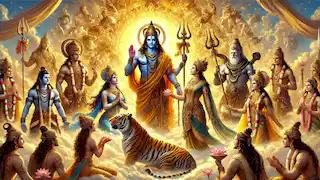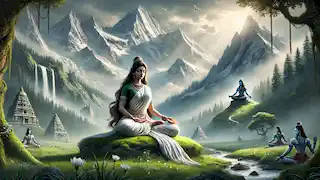The story of Shiva and Parvati is one of love, patience, and divine union. It takes place in the mystical land of India, where gods and goddesses walk among humans, and where the balance of the universe is carefully maintained through their actions. Shiva, the destroyer of evil and transformer, represents both asceticism and the destruction necessary for new growth. Parvati, his divine consort, embodies love, fertility, and devotion, complementing Shiva in every way. Together, they are the ultimate cosmic power, symbolizing the merging of opposites to form unity. In the depths of the Himalayas, amidst the towering peaks and serene valleys, there once lived a beautiful maiden named Parvati. She was the daughter of Himavan, the king of the mountains, and his queen, Mena. Parvati’s beauty was unparalleled, her kindness and grace unmatched. Her heart, however, had always been captivated by the enigmatic and powerful Lord Shiva, who resided in deep meditation on the icy peaks of Mount Kailash. Parvati had heard tales of Shiva's greatness, of his ability to destroy evil and his embodiment of divine wisdom. But Shiva was also known as the supreme ascetic, one who had renounced the world and worldly desires. Despite this, Parvati felt a deep connection with him, and she believed that their union was destined. Her love was not just that of admiration but a profound spiritual bond that transcended the mortal plane. Determined to win Shiva's heart, Parvati began her penance. She gave up the luxuries of palace life and retreated into the forests, donning simple clothes, and living on fruits and roots. Her penance was intense and unwavering, and she focused all her thoughts and prayers on Shiva. The sun scorched her, the cold nights chilled her to the bone, but Parvati’s resolve never wavered. She meditated for years, seeking the blessings of the gods and the universe for her union with Shiva. During her penance, the god of love, Kamadeva, was summoned by the other gods. The gods, concerned about the balance of the universe, realized that only through the union of Shiva and Parvati could cosmic harmony be restored. Kamadeva was tasked with awakening love in Shiva’s heart. With his sugarcane bow and floral arrows, Kamadeva took aim at the meditating Shiva. As the arrow of love struck Shiva, his eyes snapped open, blazing with anger. His meditation had been broken, and in his fury, he incinerated Kamadeva with a single glance. Kamadeva's body turned to ash, and his spirit vanished. But something had stirred in Shiva—he had become aware of Parvati’s devotion. Although Shiva had felt the power of Parvati’s love, he was not yet convinced of her worthiness to be his consort. He decided to test her. Taking the guise of a wandering sage, Shiva approached Parvati, who was still deep in her penance. “Why are you undertaking such a severe penance, my child?” the sage asked. “I seek the hand of Lord Shiva,” Parvati replied, her voice calm and resolute. The sage laughed softly. “Shiva? He is a wild ascetic. He has no place for a princess like you. Why waste your youth on someone who roams the cremation grounds, who smears ashes on his body and has no love for wealth or beauty?” Parvati remained unmoved. “I know who Lord Shiva is. It is not his appearance or his renunciation that draws me to him. It is his divine wisdom, his compassion, and his strength. I am meant to be his consort, to be by his side for eternity.” Shiva, still in disguise, tested her further. “You are a princess. Wouldn’t a king, a mortal, suit you better? Shiva will give you nothing but hardship.” But Parvati’s love was steadfast. “Hardship with Lord Shiva is more valuable than any kingdom or wealth. I belong to him, and he to me.” At that moment, Shiva revealed his true form. His eyes softened with love as he gazed upon Parvati, recognizing her devotion and her worthiness. She had passed his test, proving her unwavering love and commitment. As Shiva and Parvati stood facing one another, their union was not yet complete. The universe itself seemed to hold its breath, waiting for this divine marriage to be solemnized. The gods, led by Vishnu and Brahma, descended from the heavens to bless this union. Vishnu, the preserver of the universe, spoke first. “Lord Shiva, Parvati’s love for you is boundless, and your union will bring great harmony to the cosmos. This is not just a marriage of two souls but a merging of the forces of creation and destruction, of asceticism and devotion.” Brahma, the creator, added, “It is through your marriage that balance will be maintained. You both represent the cycle of life, death, and rebirth.” The gods arranged for a grand wedding to be held in the sacred land of Kashi, also known as Varanasi. The entire universe was invited, from celestial beings to the humblest of creatures. The preparations for the divine wedding began, and it was to be the grandest celebration ever witnessed. On the day of the wedding, the heavens and the earth alike were adorned with flowers. The sun shone brightly, and a gentle breeze carried the sweet fragrance of jasmine and sandalwood. Parvati, dressed in the finest silk, adorned with jewels that sparkled like the stars, looked like a goddess descended from the heavens, as indeed she was. Shiva, too, was resplendent, though true to his nature, he appeared in a way that both awed and puzzled the guests. He wore tiger skin, had a serpent coiled around his neck, and his body was smeared with ash. But his eyes were filled with love for Parvati, and in them, she saw the universe itself. The wedding ceremony was conducted with great reverence. The sacred fire burned brightly, and the mantras chanted by the priests echoed across the cosmos. As Shiva and Parvati circled the fire, their hands joined, they made vows not just to each other but to the entire universe. It was a union of cosmic importance, for through their marriage, the balance of the world was maintained. The gods showered flowers from the heavens, and the earth rejoiced. The marriage of Shiva and Parvati symbolized the merging of opposites—masculine and feminine, destruction and creation, asceticism and worldly life—into a harmonious whole. After the wedding, Shiva and Parvati retired to Mount Kailash, where they lived together in divine harmony. Parvati brought warmth and love to Shiva’s life, softening his ascetic nature without diminishing his power. Together, they ruled the cosmos, and their love became an example for all beings, mortal and divine alike. Though Shiva remained the destroyer and ascetic, Parvati’s presence added a new dimension to his life. She encouraged him to engage with the world, to see the beauty in creation and not just the necessity of destruction. Parvati’s love transformed Shiva, not by changing who he was, but by bringing balance to his existence. Together, they had two sons: Kartikeya, the god of war, and Ganesha, the remover of obstacles. Both sons played important roles in maintaining the order of the cosmos, reflecting their divine parentage. The marriage of Shiva and Parvati is not just a story of love but a representation of cosmic forces. Shiva, as the destroyer, is necessary for the cycle of life and death. Without destruction, there can be no creation, and without renunciation, there can be no love. Parvati, as the goddess of fertility, love, and devotion, balances Shiva’s destructive power with her nurturing energy. Together, they symbolize the balance of opposites—creation and destruction, renunciation and devotion, asceticism and worldly life. Their marriage is a metaphor for the union of the soul with the divine, where the individual self merges with the universal consciousness. The story of their union also emphasizes the importance of devotion and perseverance. Parvati’s unwavering love and her severe penance show that true devotion can overcome even the most difficult obstacles. Her determination and patience ultimately won her the heart of the one who seemed unattainable, teaching that love and faith are powerful forces. The story of Shiva and Parvati continues to inspire millions today. In temples across India and beyond, devotees offer prayers to this divine couple, seeking blessings for harmony in their own lives. Shiva and Parvati are often worshipped together, symbolizing the perfect balance between opposites. The symbolism of their union transcends religious boundaries, offering lessons on the importance of balance, love, and devotion in all aspects of life. Their story reminds us that even in the face of great challenges, love and perseverance can bring about divine union and cosmic harmony. {{{_04}}} The marriage of Shiva and Parvati is a tale of divine love, devotion, and balance. It represents the eternal dance of creation and destruction, asceticism and worldly engagement, and the harmonious union of opposites. Their story continues to resonate with people across cultures, offering a timeless message of perseverance, devotion, and the power of love.The Beginnings of the Story
Parvati's Devotion
Shiva Tests Parvati
The Intervention of the Gods

The Wedding of Shiva and Parvati

Life After Marriage

The Cosmic Significance
Shiva and Parvati in the Modern World
Conclusion
The Story of the Marriage of Shiva and Parvati
Reading Time: 8 min

About Story: The Story of the Marriage of Shiva and Parvati is a Myth Stories from india set in the Ancient Stories. This Descriptive Stories tale explores themes of Romance Stories and is suitable for All Ages Stories. It offers Cultural Stories insights. A divine union that shaped the balance of the cosmos.

















